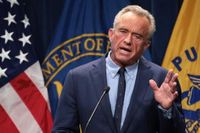When Robert F. Kennedy Jr. took the helm as U.S. Secretary of Health and Human Services in April 2025, he wasted no time making bold promises. During a news conference on April 16, Kennedy vowed a "massive testing and research effort" to finally uncover what he called the environmental causes behind the dramatic rise in autism spectrum disorders. His pledge, delivered with characteristic confidence, was simple and sweeping: "We’re going to get real studies done for the first time." He even set a deadline—by September, the nation would have answers.
Yet, as NPR and ProPublica have reported, the reality behind Kennedy’s campaign has been anything but straightforward. In a twist that has left many scientists stunned, Kennedy’s tenure has been marked by the elimination of divisions actively investigating environmental links to autism and the slashing of millions in federal research funds. The contradiction is striking: while Kennedy talks up a new $50 million autism research initiative, he’s simultaneously dismantled the very infrastructure that could have delivered the answers he seeks.
For researchers like Erin McCanlies, the disconnect has been personal and painful. As an epidemiologist at the National Institute for Occupational Safety and Health (NIOSH)—an agency under Kennedy’s purview—McCanlies spent nearly two decades studying how parents’ exposure to workplace chemicals might increase their children’s risk of autism. Just three weeks before Kennedy’s April announcement, she was finalizing her fourth major paper on the topic. Then came the news: her entire division was eliminated.
“That’s exactly what I’ve been doing!” McCanlies recalled telling her husband, Fred, after hearing Kennedy’s promise to find the cause of autism. Her work, and that of dozens of colleagues, was abruptly halted. According to ProPublica, more than $40 million in grants for autism-related research projects were canceled under Kennedy’s watch, including studies at major universities and projects targeting environmental risk factors.
Kennedy’s approach to autism has long been controversial. For 20 years, he’s promoted the debunked theory that vaccines cause autism, often dismissing contrary evidence as the product of industry trickery. In a June interview with right-wing host Tucker Carlson, Kennedy doubled down: “We need to stop trusting the experts,” he said, suggesting that previous studies were marred by bias and self-interest. Despite overwhelming scientific consensus that vaccines do not cause autism, Kennedy remains skeptical of the research funded by his own agency.
Meanwhile, Kennedy’s leadership coincides with a broader rollback of environmental protections. The Trump administration, with Kennedy’s apparent acquiescence, has reversed regulations on pollution and chemicals—including some linked to autism in recent studies. The Environmental Protection Agency (EPA), led by Administrator Lee Zeldin, has rolled back rules that will increase air pollution and reversed bans on chemicals like trichloroethylene (TCE) and methylene chloride, both associated with autism risk. The EPA has also dismantled its Office of Research and Development, which had funded crucial studies on environmental contributors to autism. More than 2,300 workers have left the agency, many through early retirement or resignation programs.
For scientists like McCanlies and her longtime collaborator, Irva Hertz-Picciotto of the University of California, Davis, the changes are frustrating. Their research, stretching back to 2009, has consistently found links between parental exposure to workplace solvents and increased autism risk. In a 2012 study, they showed that parents of children with autism were more likely to have been exposed to solvents such as lacquer, varnish, and xylene on the job. A follow-up in 2019, involving over 950 families, found that women exposed to solvents at work during pregnancy were 1.5 times more likely to have a child with autism. Their 2023 study added a genetic dimension, showing that certain gene variants made the risk from solvent exposure even higher.
Other researchers have documented similar connections. Studies funded by the National Institute of Environmental Health Sciences (NIEHS) have linked autism risk to air pollution, pesticides, BPA (a plastic additive), and diesel exhaust. In 2021 and 2023, Hertz-Picciotto co-published work linking “forever chemicals” like PFOA and PFNA to autism. Rebecca Schmidt, another NIEHS- and NIH-funded researcher, found that folic acid supplementation during pregnancy significantly lowered autism risk—a finding confirmed by over a dozen studies.
But the research has faced headwinds. Schmidt’s $1.3 million EPA grant to study wildfire pollution’s neurological impacts was canceled in 2025, only to be reinstated after a judge’s ruling in a class-action lawsuit. The EPA, however, has appealed, leaving the project’s fate uncertain. “Millions of pregnant women are getting exposed as we speak,” Schmidt told ProPublica, highlighting the urgent need for more research and public health guidance.
As the Trump administration’s anti-regulatory agenda marches on, Kennedy has presided over his own wave of cuts. He’s likened the agency’s downsizing to shedding “unhealthy fat,” aiming to reduce the Health and Human Services (HHS) workforce by 20,000—a quarter of its staff, including many veteran scientists. Some divisions, including those studying air quality and chemical exposures, have been consolidated into a new entity: the Administration for a Healthy America. An HHS spokesperson told ProPublica the reorganization would save taxpayers $1.8 billion a year and that “critical programs will continue.”
Still, many in the autism research community see the strategy as shortsighted. Alycia Halladay, chief science officer at the Autism Science Foundation, warned, “We’re talking about probably decades of delays and setbacks. To take money away from all these areas of need to focus on a question that the HHS director considers high priority seems not scientific and not the way that science is done.”
The new $50-million Autism Data Science Initiative, housed under the NIH, seeks to fund research using large datasets to search for “possible contributors to the causes of autism.” But the process has been criticized for a lack of transparency. Unlike typical NIH programs, the names of review committee members and evaluation criteria have not been disclosed. “Some of his agenda is really ridiculous and very counterproductive,” Hertz-Picciotto said, but she’s applying for funding anyway, hoping to continue her work—and to bring McCanlies back as a consultant if her project is approved.
McCanlies, for her part, remains wary. “I don’t trust him at all,” she said of Kennedy. After a career spent quietly advancing science under seven administrations, she was forced into early retirement, finishing her final study—on the links between workplace plastics exposure and the severity of autism—amid empty halls and layoffs. Her research found that such exposures were “consistently and significantly associated” with lower cognitive scores, increased aberrant behaviors, and deficits in life skills among children with autism. The findings, now available as a preprint, recommend that regulators increase awareness of these hazards and offer clear workplace protections. But with so many experts gone, McCanlies doubts the advice will be heeded soon.
As Kennedy’s self-imposed September deadline for answers approaches, the autism community waits—caught between grand promises and the reality of gutted research infrastructure. For families, scientists, and advocates, the stakes couldn’t be higher.





